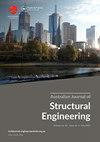不同载荷条件下轮胎包夹芯墙结构性能的试验与数值研究
IF 1.3
Q4 ENGINEERING, CIVIL
Australian Journal of Structural Engineering
Pub Date : 2021-08-30
DOI:10.1080/13287982.2021.1970699
引用次数: 0
摘要
摘要:本文研究了四点弯曲和冲切荷载作用下轮胎-包芯墙的结构性能。该研究包括两个阶段:(a)全面的实验测试和(b)三维有限元模型(FEM)的数值分析。在第一阶段,对两个轮胎包夹层墙进行了弯曲试验,以研究其在极限荷载、垂直挠度、混凝土表面应变分布、挠度剖面、裂缝模式和轮胎包压缩性方面的结构行为。第二阶段包括三个阶段:(a)通过对比荷载-挠曲曲线和混凝土受拉损伤对材料模型和不同部件的装配进行验证;(b)利用以往的实验研究数据对冲剪载荷和边界条件进行校准;(c)研究轮胎包芯墙在冲剪作用下的极限载荷和破坏模式。所建立的三维有限元模型与试验结果吻合较好,能较准确地预测出破坏机理。校正后的模型可用于进一步研究不同加载条件下影响轮胎包夹芯墙结构性能的因素。最后利用屈服线理论对钢筋混凝土构件的强度进行了确定,结果与试验值吻合较好。本文章由计算机程序翻译,如有差异,请以英文原文为准。
Experimental and numerical study on structural behaviour of tyre-bale sandwich wall under different loading conditions
ABSTRACT This study presents the structural behaviour of tyre-bale sandwich wall under four-point bending and punching shear load. The research entails two stages: (a) full-scale experimental testing and (b) and numerical analysis of a 3D finite element modelling (FEM). In the first stage, two tyre-bale sandwich walls are tested experimentally in flexural bending to investigate the structural behaviour in terms of ultimate load, vertical deflection, strain distribution on the concrete surface, deflected profile, crack pattern and tyre-bale compressibility. The second stage consisted of three phases: (a) validation of the material model and assembly of different parts by comparing load-deflection curve and concrete damage in tension, (b) calibration of punching shear load and boundary conditions using previous experimental research data and (c) study ultimate load and failure mode under punching shear in tyre-bale sandwich wall. The results of the proposed 3D FEM model showed good agreement with experimental work and predicted the failure mechanism with reasonable accuracy. The calibrated model can be used to further investigate the factors affecting the structural behaviour of tyre-bale sandwich walls under different loading conditions. Finally, the strength of reinforced concrete member was confirmed using yield line theory, which showed a fair agreement with the experimental values.
求助全文
通过发布文献求助,成功后即可免费获取论文全文。
去求助
来源期刊

Australian Journal of Structural Engineering
ENGINEERING, CIVIL-
CiteScore
2.50
自引率
0.00%
发文量
31
期刊介绍:
The Australian Journal of Structural Engineering (AJSE) is published under the auspices of the Structural College Board of Engineers Australia. It fulfils part of the Board''s mission for Continuing Professional Development. The journal also offers a means for exchange and interaction of scientific and professional issues and technical developments. The journal is open to members and non-members of Engineers Australia. Original papers on research and development (Technical Papers) and professional matters and achievements (Professional Papers) in all areas relevant to the science, art and practice of structural engineering are considered for possible publication. All papers and technical notes are peer-reviewed. The fundamental criterion for acceptance for publication is the intellectual and professional value of the contribution. Occasionally, papers previously published in essentially the same form elsewhere may be considered for publication. In this case acknowledgement to prior publication must be included in a footnote on page one of the manuscript. These papers are peer-reviewed as new submissions. The length of acceptable contributions typically should not exceed 4,000 to 5,000 word equivalents. Longer manuscripts may be considered at the discretion of the Editor. Technical Notes typically should not exceed about 1,000 word equivalents. Discussions on a Paper or Note published in the AJSE are welcomed. Discussions must address significant matters related to the content of a Paper or Technical Note and may include supplementary and critical comments and questions regarding content.
 求助内容:
求助内容: 应助结果提醒方式:
应助结果提醒方式:


